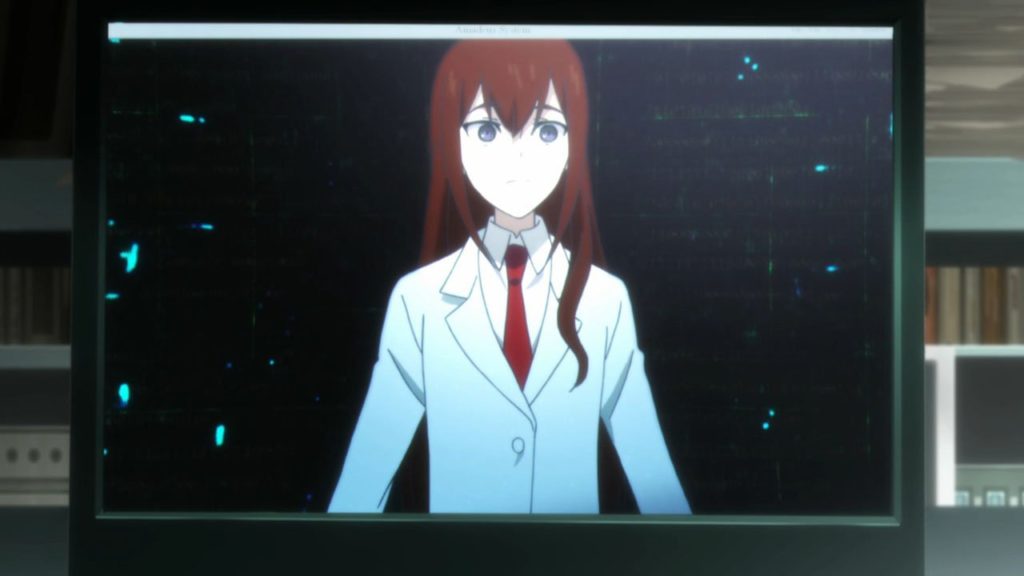Steins;Gate 0 Part 2 Review
“Stop World War III.”
Some spoilers ahead
Time-traveling Rintaro Okabe (Okarin to his friends) has returned to a timeline in which his childhood friend, Mayuri, is still very much alive, but the scientist he loves, Makise Kurisu, is dead. However, Kurisu’s colleague and friend, the diminutive and fierce Maho Hiyajo, has introduced him to the Amadeus Project which she and Professor Leskinen have been developing in the US. Amadeus utilizes Kurisu’s memories to create an interactive AI that not only looks like Okabe’s lost love, but also sounds and reacts in a very lifelike way.

Another time traveller from the future is Suzuha, Daru’s daughter, who is determined to make Okabe help her to stop World War III from breaking out (in her timeline it’s sparked by the research Okabe and his friends were conducting into time travel). As he’s the only one who retains his memories through his Reading Steiner abilities when flicking between alternate timelines, he’s also the only one who has any hope of preventing the imminent catastrophe. But who can he trust? When Kagari, the red-haired, amnesiac young woman who has travelled back with Suzuha, suddenly disappears, it looks as if everything – and not just Okabe’s fragile sanity – is about to fall apart all over again. Is Okabe the only one who can stop the imminent war?

So, what to say about Steins;gate 0 Part 2? Unfortunately the over-complicated plot implodes. What should – and could – have been a clever interweaving of time-travelling threads driving inexorably toward a resolution in which everything is resolved by Okabe arriving in the right place at the right time falls apart under the weight of its own complications. We’re shown the half-crazed, suffering Okabe too many times as he is forced to re-live the harrowing experiences he’s trying to prevent. So does this take away from the impact of an eventual reawakening of his ‘old’ Mad Scientist persona? Or is it meant to enhance its impact? I’ve watched the whole series twice (once in Japanese, once in English) as well as returning to replay certain scenes to try to work out WTF’s going on – and I still have no idea. I have questions but I suspect there aren’t going to be answers. And as for that ending – well. Would someone care to explain it to me? I grew up watching Doctor Who and I’ve experienced quite a few alternate timeline/time travel stories since then. But this one genuinely has me foxed. (Actually, my response was more one of incredulous disbelief.) You may well feel differently. Perhaps you’ve played the visual novel on which this is based and that helps.

Another issue is the relentlessly washed-out palette of colours: grey; brown; sepia; black. Obviously done to establish a grim and hopeless mood (mirroring Okabe’s state of mind?), the rare pops of colour are welcome but could have been used to greater effect.
And then there’s the use of Wolfgang Amadeus Mozart and his music – which ought to be clever and meaningful but doesn’t quite work. Apart from the parallels which Maho keeps making with her hardworking self (Salieri) and genius Kurisu (Mozart) there’s the fact that Kagari seems to have been brainwashed into awakening to a very different personality when she hears Papageno’s humming song from The Magic Flute. This plotline is foreshadowed but then not properly developed or explained; another waste.

Nevertheless, if you’re invested in the characters (as I still am, in spite of all the plot irritations) you’ll want to see this through to the end. There are episodes you won’t want to miss, especially the one where Suzuha tries her darnedest to ensure that her parents-to-be meet up and fall in love – because otherwise, she won’t exist. Or, if you’re a fan of Mayuri, you’ll be rooting for the moments when this sweet, quiet girl who always considers others before herself, suddenly shows another side to her character. And then there’s new character (to this series) Maho, undoubtedly the tsundere, who – of course – is concealing another aspect of her personality, which won’t surprise anyone if they’ve been paying attention, but is still genuinely touching. Last but not least, there’s the glimpse of the apocalyptic future which Okabe travels to, and finds his friends – or those that have survived, anyway: older, more world-weary, forced to fight to survive against the odds.

A new ED appears: “World-Line” by Asami Imai (Episodes 14-17,19-20) is rather a disappointment, packing none of the punch of Zwei’s “LAST GAME” – although the dramatic insertion of a very familiar ED, “Hacking to the Gate” by Kanako Itou, is a nice touch in Episode 23. There’s also an insert song from Kanako Itou: “Skyclad no Kansokusha” (Episode 21).
The set concludes with the OVA/Episode 24, titled “Valentine’s of Crystal Polymorphism – Bittersweet Intermedio – ” which plays to the show’s strengths in a Valentine’s Day-based episode shamelessly designed as a fan-pleaser. It might restore your faith in the series a little, especially if you look on it as a slightly bitter-sweet slice-of-life story about a group of friends preparing for February 14th…
Special Features on this Manga Entertainment set include Episode 20 Commentary, Episode 18 Video Commentary and Textless Songs. The Blu-ray discs navigate well (DVDs not seen) and the picture and sound quality is good. You can find my thoughts on the voice acting and US dub in my review of Steins;gate 0 Part 1.
If you’ve watched the first part of Steins;gate 0, you’ll want to revisit the characters and see how the story plays out. But from a science fictional point of view, this series is sadly not a success, more a lesson in how not to write time travel.
My thanks for images to Random Curiosity and Guardian Enzo for the images.


